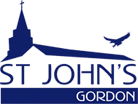Music History
Parish archives show that music has always been important to St. John’s. The Parish Gazette from 24 March 1915 records the words of the first Rector, Father Raymond King: “On Easter day the service at the 11:00AM Celebration of the Holy Communion at St. John’s, Gordon, and St. Swithun’s, Pymble, will be choral. That is to say the Creed, Sursum Corda, Sanctus, Lord’s Prayer, and Gloria in Excelsis, together with two short anthems will be sung to musical settings. On the greatest festival of the year it seems only fitting that the Lord’s Own Service should, if possible, be rendered with all the added dignity and beauty which music, the handmaid to religion, brings, and that hymns such as the Sanctus and Gloria in Excelsis should be sung rather than read. All the arguments for music at Mattins and Evensong might be adduced with even more appropriateness for the Service of the Holy Communion.”
The Parish Choir has been a constant since then. The Parish History records:
“Easter has been the time for cantatas and God so Loved the World and The Cross of Christ were performed by a choir on many occasions during the 1970s and special renditions on other occasions.” The Parish Review of February 1997 recorded: “During the whole of the Christmas Season, the choir, ably led by Mr. and Mrs. Anderson, added dignity and devotion to our worship.”
In the 1980s and 1990s, choirs from nearby parishes and schools performed at St. John’s, sometimes with the Parish Choir. The St. John’s Choir also sang at other churches and joined with other choirs. Another feature of the 1980s was the St. John’s Junior Choir; other boys’ and girls’ choirs from Sydney and New Zealand also sang at St. John’s at this time. In 1997, the 125th anniversary of the parish was celebrated with a series of choral concerts and the Choir Reunion on 19 October. Graham and Enid Anderson, directing the music, made a significant impact on the life of the parish in this era. We remain grateful for their foundational legacy.
The period from 2008 saw a further blossoming of musical activities. Choirs support worship services such as the annual Passion Service on Palm Sunday and Choral services marking Advent and Christmas. The use of instruments other than organ in worship has also been a development with trumpets, strings, period viols for Baroque music, as well as slightly larger instrumental ensembles. In 2009 The Cathedral Singers were welcomed as a Choir-in-Residence and they sing Stainer’s Crucifixion on Good Friday every year. Evensong was re-established in 2009 as a fully choral service held monthly.
Choirs continue to be an important part of worship at St. John’s, accepting anyone who wishes to sing, whether they have much or minimal choral or musical experience. The depth of activity has been enhanced with a breadth appropriate to a parish setting and offers opportunities for community through music where such activities are decreasing elsewhere.
An essential tool of an Anglican music programme is the organ. No mention is made of an organ in the old Blackett Church in the parish histories, and it can be assumed that, like so many other small churches, a reed organ was used. The Blackett church was extended in 1899, but still proved too small for the growing number of worshippers. St. John’s second Rector, Father Arnold Conolly, set about building the first stage of the new church in 1924. It was designed with enough space in the chancel and sanctuary to accommodate an organ and a choir.
The parish history records in about 1930 that the “Choir was a feature of the worship and would do fair to any modern church in number and performance. Despite the debt on the building a fine church organ was acquired.” This was the 1928 Rendall organ and it was recorded in about 1933 that it “proved to be temperamental. Its performance varied with the weather.” This was a stock instrument, and not specifically built for St. John’s. As the church was completed in sections (1935, 1967), the organ was also extended (1956, 1972). A special series of recitals were performed after the dedication of the new console in 1988. While there was also an amateur-built organ in the western gallery at St. John’s from about 1992, this instrument was not suitable and has been de-acquisitioned.
St. John’s acquired the beautiful Hill organ in February 2012. While this small instrument is inadequate to fully support congregational singing in a building this size, it is of excellent quality and continues to be used far more often than originally anticipated to accompany choirs and soloists.
The new organ at St. John’s was built by the South Island Organ Company (New Zealand) and installed in 2019. Its clever design enables musical flexibility and gives the feel and sound of a much larger instrument than it really is. This is achieved with organ building techniques called extensions and duplications, resulting in an instrument of four manuals (keyboards) and 55 sounding stops. This enables it to play both traditional parish music in addition to some of the more complicated examples of choral accompaniment and organ repertoire. The SIOC organ provides many sound colours to enhance the liturgy of St. John’s, underline the meaning of Biblical and liturgical texts that are sung, provide authentic performance of choral and organ repertoire, and musically excite worshippers and visitors to St. John’s for years to come.
Music continues to be an important feature of St. John’s, Gordon. We hope you too can join us in community and worship through music. Contact the Director of Music for further details.


